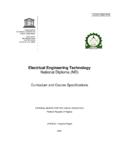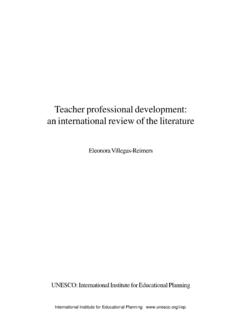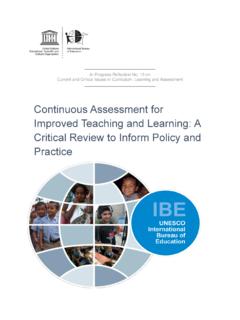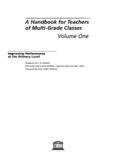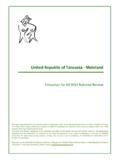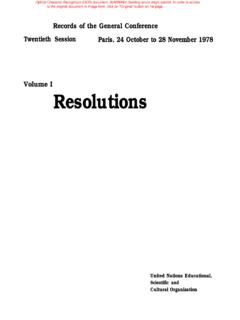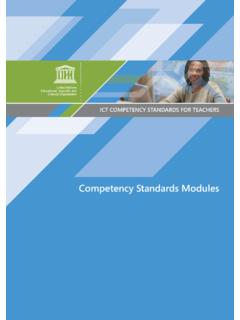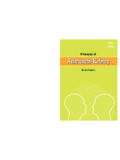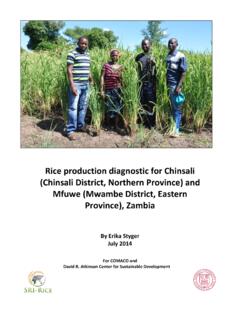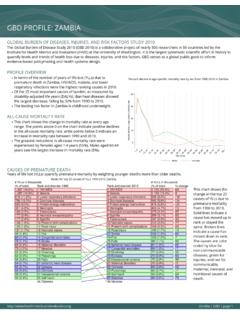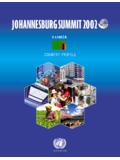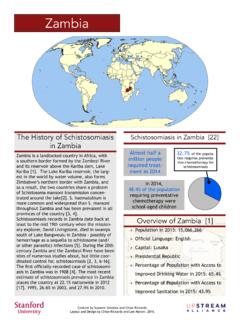Transcription of Zambia: education policy review; paving the way for SDG 4 ...
1 United NationsEducational, Scientific andCultural OrganizationZambiaEducation policy review : paving the Way for SDG 4 education 2030 September 2016 ZambiaEducation policy ReviewSeptember 2016 ZambiaUNESCOE ducation policy ReviewED-2016/WS/373 ForewordSince it achieved independence in 1964, zambia , in contrast to most of the countries it borders, has experienced a period of political stability. With strong and sustained economic growth over the last decade, zambia is now classed as a lower middle-income country. The Government s commitment to education has been clear since it passed the 1964 education Act governing the financing and management of education in zambia . education development has been among the Government s main priorities, as indicated by the stable share of government spending devoted to education , as well as successive education sector plans (NIF-I, NIF-II, NIF-III) and associated policy a period of decline in education delivery and performance, due to growing poverty and underinvestment in education between 1980 and 2001, zambia has undertaken considerable policy development and reform to meet evolving national aspirations and social demands to improve its national education system.
2 Free basic education (FBE) was, for example, introduced in 2002, through the Basic Educational Sub-sector Investment Programme (BESSIP). Such policy initiatives have resulted in increased access to basic education , improved infrastructure, and enhanced equity at primary level. zambia is not only close to achieving universal primary education (UPE), but is also approaching universal lower secondary education . The Government s current education strategy is to expand investment to develop upper secondary education , technical education , vocational and entrepreneurship training (TEVET), and higher education . This strategy is not only in line with the education 2030 Agenda, but also drives to the country s vision to become a prosperous middle income country by 2030 .It is important to note that zambia s sustained economic growth has not yet been translated into significant poverty reduction.
3 Almost 60 per cent of the population still live below the poverty line. Wide disparities exist between population strata, as well as between urban and rural areas, particularly in education . Despite the improvements made in education , huge challenges remain in terms of education quality, relevance, internal efficiency, and equity, as well as in the effectiveness and efficiency of educational service delivery. For example, notwithstanding the progress made towards UPE, an estimated 195,582 Zambian children were out of school in 2013 (World Bank, 2015). Furthermore, the transition rate to upper secondary education has fallen steeply, from 50 per cent in 2007 to 37 per cent in 2014. The dropout rates are significantly higher for orphans and vulnerable children (OVCs), students from poorer families, and those attending schools in rural areas.
4 Student 4performances in national examinations, and national and international large-scale assessments, are well below expectations, as witnessed by the country s Southern and Eastern African Consortium for Monitoring Educational Quality (SACMEQ) results. Performance in Zambian schools remains below the minimum standards established by the Ministry of education (MoE). Weak policy implementation, combined with inadequate funding, has undermined the effectiveness and efficiency of education service delivery in zambia . This was particularly evident in the poor implementation of decentralization policy , inefficient intra-sectoral budget allocation, and the erratic and often late release of the education budget. All these difficulties have been exacerbated by weak education planning and promisingly, however, zambia is striving to address these challenges, though its success will depend on how well these efforts are sustained.
5 Under the revised Sixth National Development Plan (SNDP), the National Implementation Framework (NIF) III provides a comprehensive sector development plan with clear targets, aligned with the national Vision 2030 as well as with the fourth Sustainable Development Goal, to ensure inclusive and quality education for all. Given the recommendations of a number of recent appraisals, this one included, it is expected that the Government will make the necessary efforts to ensure an effective and efficient implementation of its sector development plan. This education policy review is UNESCO s contribution to supporting zambia in this undertaking. Thanks to the CapED (Capacity Development for education ) programme, UNESCO will be able to sustain its commitment to helping zambia address some of the recommendations of this policy review , particularly those related to capacity development for the smooth implementation of its sector development AtchoarenaDirectorDivision for Policies and Lifelong Learning SystemsEducation SectorUNESCO 5 Table of ContentsForeword.
6 3 List of of Figures ..11 List of ..15 Executive Summary .. education policy review in zambia .. issues policy and planning .. 19 Teacher policies and development .. and Adult literacy and education ..27 Monitoring and assessment of learning achievement (MALA)..32 Introduction .. of the report ..36 review method ..37 Boundaries and limitations ..37 Chapter 1 Context of education Development .. The country ..41 Societal aspects .. Overview of the education system ..43 Constitutional and legal framework ..43 education governance in zambia ..45 education decentralization in zambia ..46 education policy and planning ..50 Status and trends in education 2 education Sector: Overall Appraisal .. childhood care development and education ..56 Primary education ..57 Secondary education ..59 Tertiary Quality and relevance ..64 Teaching and learning qualifications.
7 66 Teacher education and and vulnerable children children ..75 MoGE s equity interventions ..77 Multi-sectoral interventions for inclusive education .. Effectiveness ..79 Literacy rates ..79 School-life expectancy ..81 Student performance .. expenditure devoted to education ..85 Performance relative to Overall 3 review of Priority policy System-wide policy and issue 1: Ineffective implementation of the policy to decentralize education ..97 policy issue 2: Weak budgetary performance: late, erratic, and inadequate issue 3: Inefficient intra-sectoral budget allocation and issue 4: Weak national capacities for effective strategic planning .. Teacher policies and development ..136 Current context of teacher education and policies in issue 1: Low training capacity and inadequate teacher Issue 2: Inadequate continuous professional development programmes.
8 143 policy Issue 3: Inadequate policies for remuneration and career Issue 4: Weak utilization of information and communications technology for implementing continuing professional development programmes ..152 policy Issue 5: Lack of facilities and resources, and weak capacity and qualifications of staff at teacher education institutions ..156 policy Issue 6: Low status, morale, and professionalism of teachers .. Technical education , Vocational and Entrepreneurship Training ..167 Legal and policy framework ..167 System steering and delivery: registered institutions ..171 Access to and participation in formal TEVET ..173 Labour market characteristics and employment information on labour for and supply of labour ..180 Recent trends in labour force and youth employment ..181 policy measures addressing issues of youth employment ..184 Private investment and entrepreneurship opportunities and policy Issues.
9 187 policy issue 1: Limited and inequitable access to TEVET ..188 policy issue 2: The reservation about the roll-out of the two-tier system being introduced by the Zambian issue 3: Lack of public funding for issue 4: Weak TEVET responsiveness to the labour issue 5: Curriculum development not relevant to labour market requirements ..216 policy issue 6: Lack of quality Issue 7: Low quality of Youth and Adult literacy and education (YALE)..232 Introduction: Context and policy environment of YALE in zambia ..232 YALE institutions and provision in zambia ..234 Brief history, status of and trends in issues and challenges in YALE in zambia ..240 policy issue 1: Lack of a comprehensive national YALE policy and weak reflection of lifelong learning perspective in YALE issue 2: Limited and inequitable access to issue 3: Inadequate funding, structures and capacity for YALE.
10 252 policy issue 4: Issues related to quality, results, efficiency, and Monitoring and assessment of students learning current status of MALA in zambia ..262 policy issue 1: Absence of a formative orientation of the current MALA issue 2: Lack of use of MALA data to inform issue 3: Inadequate orientation of the current provision of continuous professional development (CPD) programmes for teachers in issue 4: Lack of a comprehensive M&E system..2819 List of TablesTable 1 Trends in GDP growth (2005 2015) 40 Table 2 Development measures comparator countries/regions 55 Table 3 Gross enrolment rates (%) in pre-school education 57 Table 4 Transition rate from primary to lower secondary education (%) 59 Table 5 Gross enrolment ratio for upper secondary education 61 Table 6 Percentage of 10 14-year-old children attending school by survivorship of parents 74 Table 7 Percentage of Zambian out-of-school children: Primary (ages 7-13) 76 Table 8 zambia s performance.
